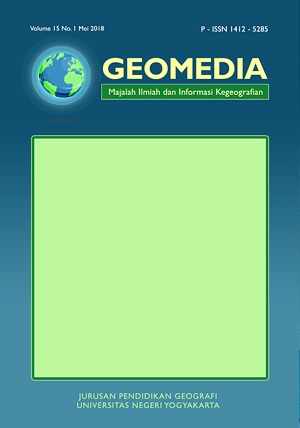Pemanfaatan Foto Udara Multispektral Untuk Sidik Cepat Kerapatan Tutupan Vegetasi Di Wilayah Perkotaan
DOI:
https://doi.org/10.21831/gm.v21i1.35907Abstract
Current technology enables NDVI analysis of multispectral aerial photographs, providing fast, detailed actual vegetation cover information. However, no study shows the best threshold value for mapping vegetation cover in urban areas. This study aims 1) to compare the area of vegetation cover on a semi-detailed and detailed scale, and 2) to determine the best NDVI threshold for mapping vegetation cover in urban areas. This study uses multispectral aerial photographs and Sentinel-2 satellite imagery (positioned as the baseline). Aerial imagery and photographs are processed for visible, red, and NIR bands. Band image processing and aerial photographs were used for NDVI analysis. The results show that the best threshold is at NDVI 0.2. The results of the identification of vegetation cover with Sentinel-2 imagery showed an area of 6.37 hectares or 28,2%, while the aerial photos resulted in an area of 11.4 hectares or 50,5%. The difference in area between the two spatial data is due to differences in the resolution of Sentinel-2 imagery with aerial photographs, 4 cm, and 10 m.
Downloads
Published
How to Cite
Issue
Section
Citation Check
License
Authors who publish in this journal agree to the following terms:
- Authors retain copyright and grant the journal the right of first publication with the work simultaneously licensed under a Creative Commons Attribution License that allows others to share the work with an acknowledgment of the work's authorship and initial publication in this journal.
- Authors are able to enter into separate, additional contractual arrangements for the non-exclusive distribution of the journal's published version of the work (e.g., post it to an institutional repository or publish it in a book), with an acknowledgment of its initial publication in this journal.
- Authors are permitted and encouraged to post their work online (e.g., in institutional repositories or on their website) prior to and during the submission process, as it can lead to productive exchanges, as well as earlier and greater citation of published work (See The Effect of Open Access).

Geo Media: Majalah Ilmiah dan Informasi Kegeografian is licensed under a Creative Commons Attribution-ShareAlike 4.0 International License.
Based on a work at https://journal.uny.ac.id/index.php/geomedia.











